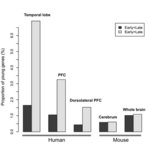Evolution

The evolution of the human brain is the topic of a lot of research. This shouldn’t be surprising since it is so well-developed in human beings, and, as many believe, it is one of the main traits that sets us apart from our close evolutionary relatives. The seat of consciousness, culture, science, technology, and so on, exerts a great desire upon people to understand it, and to understand how it could have evolved. In order to study this question, a new study, published in PLoS Biology, investigated the occurrence and activity of evolutionary young genes in human brain development.
The…

Global warming is bad but at least we have a chance to control it. Simple life hundreds of millions of years ago had to just go with the flow so when global glaciation put a chill on things back then, the only way even simple life in the form of photosynthetic algae could have survived was in a narrow body of water with characteristics similar to today's Red Sea, according to a new study in Geophysical Research Letters.
Many scientists believe Earth became a giant snowball two or three times between 800 million and 550 million years ago, with each episode lasting about 10 million…

A particular kind of sugar molecule had a big impact on human evolution and may have directed the evolutionary emergence of our ancestors, according to a new study in Proceedings of the National Academy of Sciences, the first evidence of a link between cell surface sugars, Darwinian sexual selection, and immune function in the context of human origins
Sialic acids are sugar molecules found on the surfaces of all animal cells, where they serve as vital contact points for interaction with other cells and with the surrounding environment, including as targets for invasive pathogens. For…

Cooperation has been/still is a major factor in the success of the human species, and in many others as well. Altruism and fairness are thought to play an important role in the development of cooperation. But when in a human life do these traits develop? For quite some time, it was thought that they developed fairly late in ontogeny.
Lately, however, there has been some incipient research into the moral and prosocial behaviors of young children. A new study investigated the sense of fairness and tendency to be altruistic in 15-month-old infants.
A first experiment concerned the violation-of-…

Today's post in honor of the 2011 Cephalopod Awareness Days. October 9th is Nautilus Night.500 million years ago, at the time of the Cambrian Explosion, there was no life on land. The ocean held plenty of trilobites and other animals, but they all lived on the seafloor--almost nobody swam freely in the water. Plectronocerus, the first fossil cephalopod, evolved and crawled on the floor just like everyone else.
But pretty soon cephalopods began to defy gravity, filling their shells with buoyant gas. Like deadly dirigibles, they cruised through the water and attacked their…

This TED video of Christoph Adami is about life, and how to look for it. He begins by talking about the apparent difficulty in defining life (click here for a post about inorganic life) (funny that he mentions the creature that can age backwards, more about that here), and goes on with a discussion about artificial life on the computer. Finally, he answers the question 'How to look for life?' by frequency distributions. He concludes:
Life can be defined in terms of information processes.
We can make life inside a computer, and
We are able to look for life that's unlike what we know.…

Males of many species guard the females they have mated with, a behavior generally interpreted as a tactic to reduce the likelihood that rival males will mate with the female. This, of course, can lead to a conflict between the sexes: where females might want to mate with other males, males will try to prevent this. In this case, the male-female association is based on conflict.
A new study on crickets (Gryllus campestris, see figure 1), however, suggests that the foundation of the couple’s association might be based on cooperation. By continuously monitoring natural cricket populations with…

In which context did life arise? A problem yet unsolved. Several plausible ideas and hypotheses have been put forward: shallow seas, meteorites (see DNA, Made In Space?), and even much more extreme habitats, such as hydrothermal vents. Perhaps pumice should be added to the list?
Pumice (see figure 1), a volcanic rock formed by solidified frothy lava, is known to be porous and, once upon a time in its history, gas-rich. Now, a new study, published in Astrobiology, poses that extensive rafts of pumice have four properties that would actually make them a suitable candidate for the location where…

I didn't need to be persuaded that evolution happened.
In fact, upon finding out in my teens that there were people that rejected it, I can say that my reaction was one of utter confusion. Why on earth would someone believe it not to be true? It seemed pretty obtuse and a little alien, like objecting to atomic theory or something similar for no reason whatsoever.
Anyway, suffice to say, I'm little more educated about the whole movement against evolution now. And, however confused you are about the nature of evolution and the proof for it, I have to say that; what I'm going to talk about is…

A new study in Nature shows that genetic parasites invaded the mammalian genome more than 100 million years ago and dramatically changed the way mammals reproduce.
The molecular changes allowed mammals to carry their developing young within the womb rather than laying them in nests or carrying them around in pouches - the uterus was transformed.
The findings published online Sept. 25 in the journal Nature Genetics describe in unprecedented detail the molecular changes that allowed mammals to carry their developing young within the safety of the womb rather than laying them in nests or…